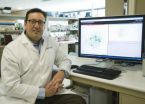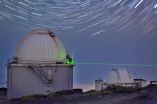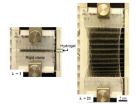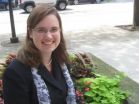(Press-News.org) The locations of millions of DNA 'switches' that dictate how, when, and where in the body different genes turn on and off have been identified by a research team led by the University of Washington in Seattle. Genes make up only 2 percent of the human genome and were easy to spot, but the on/off switches controlling those genes were encrypted within the remaining 98 percent of the genome.
Without these switches, called regulatory DNA, genes are inert. Researchers around the world have been focused on identifying regulatory DNA to understand how the genome works. Using a new technology developed with funding from the National Human Genome Research Institute's ENCODE (ENCyclopedia Of DNA Elements) project, UW researchers created the first detailed maps of where regulatory DNA is located within hundreds of different kinds of living cells. They also compiled a dictionary of the instructions written within regulatory DNA -- the genome's programming language.
The findings are reported in two papers appearing in the Sept. 5 online issue of Nature.
"These breakthrough studies provide the first extensive maps of the DNA switches that control human genes," said Dr. John A. Stamatoyannopoulos, associate professor of genome sciences and medicine at the University of Washington, and senior author on both papers. "This information is vital to understanding how the body makes different kinds of cells, and how normal gene circuitry gets rewired in disease. We are now able to read the living human genome at an unprecedented level of detail, and to begin to make sense of the complex instruction set that ultimately influences a wide range of human biology."
Here are the key results:
1) The first detailed maps of regulatory DNA switches that make up the genome's 'operating system'.
The instructions within regulatory DNA are inscribed in small DNA 'words' that function as the docking sites for special proteins involved in gene control. In many cases, these switches are located far away from the genes that they control. To map the regulatory DNA regions, the researchers harnessed a special molecular probe -- an enzyme called DNaseI -- that snips the genome's DNA backbone. Under the right conditions, these snips occur precisely where proteins are docked at regulatory DNA. By treating cells with DNase I and analyzing the patterns of snipped DNA sequences using massively parallel sequencing technology and powerful computers, the researchers were able to create comprehensive maps of all the regulatory DNA in hundreds of different cell and tissue types. They found that of the 2.89 million regulatory DNA regions they mapped, only a small fraction -- around 200,000 -- were active in any given cell type. This fraction is almost totally unique to each type of cell and becomes a sort of molecular bar code of the cell's identity. The researchers also developed a method for linking regulatory DNA to the genes it controls. The results of these analyses show that the regulatory 'program' of most genes is made up of more than a dozen switches. Together, these findings greatly expand the understanding of how genes are controlled and how that control may differ between normal and diseased cells.
2) The first extensive map of regulatory protein docking sites on the human genome reveals the dictionary of DNA words comprise the genome's programming language.
The instructions for turning genes on and off are written in DNA switches called regulatory DNA. These switches are scattered throughout the non-gene regions of the human genome. Having mapped the locations of the regulatory DNA switches, UW researchers wanted to know what made them tick. These regions contain small chains of DNA 'words' that make up docking sites for special regulatory proteins involved in gene control. The human genome contains hundreds of genes that make such proteins.
However, current technologies only allow such proteins to be studied one at a time. They also lack the accuracy to resolve the DNA letters to which the proteins dock. As a result, most of the actual DNA words recognized by regulatory proteins in living cells were unknown. To find them, the researchers employed a simple, powerful trick that enabled them to study all the proteins at once.
Instead of trying to see proteins directly, they looked for their shadows or 'footprints' on the DNA. To accomplish this, they again turned to the DNaseI enzyme that snips the DNA backbone within regulatory DNA. Prior work had shown that DNaseI likes to snip DNA next to regulatory protein docking sites, but not within the docking site itself. By using next-generation DNA sequencing technology, the researchers analyzed hundreds of millions of DNA backbone breaks made when cells were treated with DNaseI. They then used a powerful computer to resolve millions of protein footprints. In total, they identified 8.4 million such footprints along the genome, some of which were detected in many cell types. Next, they compiled all of the short DNA sequences to which the proteins were docked. They analyzed them using a software algorithm that required hundreds of microprocessors working simultaneously. This revealed that more than 90 percent of the protein docking sites were actually slight variants of 683 different DNA words -- essentially a dictionary of the genome's programming language.
"These findings significantly advance the understanding of how the instructions for controlling genes are written and organized throughout the genome, and how combinations of different instruction sets function together to control genes, often at great distance along the genome," Stamatoyannopoulos said. "The broad spectrum of cell and tissue types included in these analyses provide an incredibly rich resource that can be mined immediately by researchers around the world to illuminate how the genes they are studying are controlled."
The scientists determined that genes are connected in a complex web. In this web, regulatory DNA regions typically control one or at most a few genes, but genes receive inputs from large numbers of regulatory regions. The researchers also found evidence for a combinatorial code that helps match regulatory DNA with the right genes. Another key finding was that the regulatory DNA controlling genes involved in cancer and other types of 'immortal' cells that can keep on growing indefinitely appears to acquire mutations at a different rate than other kinds of regulatory DNA. This result points to a previously unknown link between genome function and patterns of DNA variation in individual human genomes. The finding may have implications for understanding susceptibility to cancer.
The findings reported in these papers are expanded upon in two related papers to be published simultaneously in the journals Science and Cell. In the Science paper, UW researchers further expanded the regulatory DNA maps, and compared them with genetic maps of human disease. Their studies revealed that most DNA variants associated with specific human diseases or clinical traits are located in regulatory DNA rather than in gene sequences. In the Cell paper, the researchers describe using the detailed information on regulatory protein docking sites to create a comprehensive map of how those proteins are wired.
INFORMATION:
Millions of DNA switches that power human genome's operating system are discovered
Scientists created comprehensive maps of elusive gene-controlling DNA and a dictionary of the human genome's programming language
2012-09-06
ELSE PRESS RELEASES FROM THIS DATE:
Call for a new approach to fighting tuberculosis
2012-09-06
Boston, MA – Each year, nearly 2 million people die from tuberculosis – a treatable disease that has been brought under control in the United States, but continues to ravage other parts of the world. This health inequity should prompt a complete rethinking of the way tuberculosis is fought on a global level, argue Salmaan Keshavjee, MD, PhD, and Paul Farmer, MD, PhD, from Brigham and Women's Hospital (BWH). Their argument appears in an essay published September 6 in the New England Journal of Medicine.
"The global approach to fighting tuberculosis has been lacking," ...
Comprehensive transcriptome analysis of human ENCODE cells
2012-09-06
ENCODE, an international research project led by the National Human Genome Research Institute (NHGRI), has produced and analyzed 1649 data sets designed to annotate functional elements of the entire human genome. Data on transcription starting sites (TSS) contributed by a research team at the RIKEN Omics Science Center provided key anchor points linking the epigenetic status of genes observed at the 5' end directly to their RNA output.
The ENCODE (Encyclopedia of DNA Elements) project aims to delineate all functional elements encoded in the human genome. Thirty-two institutes ...
Quantum physics at a distance
2012-09-06
This press release is available in German.
Physicists at the University of Vienna and the Austrian Academy of Sciences have achieved quantum teleportation over a record distance of 143 km. The experiment is a major step towards satellite-based quantum communication. The results have now been published in "Nature" (Advance Online Publication/AOP).
An international team led by the Austrian physicist Anton Zeilinger has successfully transmitted quantum states between the two Canary Islands of La Palma and Tenerife, over a distance of 143 km. The previous record, set ...
Tough gel stretches to 21 times its length, recoils, and heals itself
2012-09-06
Cambridge, Mass. - September 5, 2012 - A team of experts in mechanics, materials science, and tissue engineering at Harvard have created an extremely stretchy and tough gel that may pave the way to replacing damaged cartilage in human joints.
Called a hydrogel, because its main ingredient is water, the new material is a hybrid of two weak gels that combine to create something much stronger. Not only can this new gel stretch to 21 times its original length, but it is also exceptionally tough, self-healing, and biocompatible—a valuable collection of attributes that opens ...
The ENCODE Project publishes new genomic insights in special issue of Genome Research
2012-09-06
Genome Research publishes online and in print today a special issue dedicated to The ENCODE (ENCyclopedia Of DNA Elements) Project, whose goal is to characterize all functional elements in the human genome. Since the completion of the pilot phase of the project in 2007, covering 1% of the genome, The ENCODE Consortium has fanned out across the genome to study function and regulation on an unprecedented scale. This special issue presents novel findings, methodologies, and resources from ENCODE that bring extensive insight to gene regulation and set the stage for future ...
BUSM/VA researchers examine new PTSD diagnosis criteria
2012-09-06
(Boston) – Results of a study led by researchers at Boston University School of Medicine (BUSM) and the Veterans Affairs (VA) Boston Healthcare System indicate that the proposed changes to the diagnosis of post-traumatic stress disorder (PTSD) will not substantially affect the number of people who meet criteria for the disorder.
Mark W. Miller, PhD, associate professor at BUSM and a clinical research psychologist at the National Center for PTSD at VA Boston Healthcare System served as lead author of the study, which is published online in Psychological Trauma: Theory, ...
Seeing the birth of the universe in an atom of hydrogen
2012-09-06
Windows to the past, stars can unveil the history of our universe, currently estimated to be 14 billion years old. The farther away the star, the older it is — and the oldest stars are the most difficult to detect. Current telescopes can only see galaxies about 700 million years old, and only when the galaxy is unusually large or as the result of a big event like a stellar explosion.
Now, an international team of scientists led by researchers at Tel Aviv University have developed a method for detecting galaxies of stars that formed when the universe was in its infancy, ...
Genome-wide scan maps mutations in deadly lung cancers; reveals embryonic gene link
2012-09-06
Scientists have completed a comprehensive map of genetic mutations linked to an aggressive and lethal type of lung cancer.
Among the errors found in small cell lung cancers, the team of scientists, including those at the Johns Hopkins Kimmel Cancer Center, found an alteration in a gene called SOX2 associated with early embryonic development.
"Small cell lung cancers are very aggressive. Most are found late, when the cancer has spread and typical survival is less than a year after diagnosis," says Charles Rudin, M.D., Ph.D., professor of oncology at the Johns Hopkins ...
Hospital-acquired UTIs rarely reported in data used to implement penalties
2012-09-06
ANN ARBOR, Mich. — Aiming to cut expenses and improve care, a 2008 Medicare policy stopped paying hospitals extra to treat some preventable, hospital-acquired conditions – including urinary tract infections (UTIs) in patients after bladder catheters are placed.
But a statewide analysis by the University of Michigan shows there was very little change in hospital payment due to removing pay for hospital-acquired catheter-associated UTIs. For all adult hospital stays in Michigan in 2009, eliminating payment for this infection decreased hospital pay for only 25 hospital ...
LEDs winning light race to save energy, the environment
2012-09-06
RICHLAND, Wash. – Today's light-emitting diode light bulbs have a slight environmental edge over compact fluorescent lamps. And that gap is expected to grow significantly as technology and manufacturing methods improve in the next five years, according to a new report from the Department of Energy's Pacific Northwest National Laboratory and UK-based N14 Energy Limited.
"The light-emitting diode lamp is a rapidly evolving technology that, while already energy efficient, will become even more so in just a few short years," said Marc Ledbetter, who manages PNNL's solid-state ...
LAST 30 PRESS RELEASES:
Beech trees use seasonal soil moisture to optimize water uptake
How thinning benefits growth for all trees
Researchers upgrades 3-PG forest model for improved accuracy
Achieving anti-thermal-quenching in Tb3+-doped glass scintillators via dual-channel thermally enhanced energy transfer
Liquid metal modified hexagonal boron nitride flakes for efficient electromagnetic wave absorption and thermal management
Failure mechanisms in PEM water electrolyzers
Study captures how cancer cells hide from brain immune cells, shows that removing their “don’t eat me” signals stops their escape
New breakthrough in detecting ‘ghost particles’ from the Sun
Half of people arrested in London may have undiagnosed ADHD, study finds
From dots to lines: new database catalogs human gene types using ’ACTG’ rules
Persistent antibiotic resistance of cholera-causing bacteria in Africa revealed from a multinational workshop for strengthening disease surveillance
SwRI, Trinity University to synthesize novel compound to mitigate effects of stroke, heart attack
Novel endocrine therapy giredestrant improves disease-free survival over standard of care for patients with early-stage breast cancer in phase III lidERA trial
Gen Z views world as "scary place" with growing cynicism about ability to create change
Biosensor performance doubled – New applications possible
Leveraging incomplete remote sensing for forest inventory
Key chemical in dark chocolate may slow down ageing
New 15-minute hepatitis C test paves the way for same-day treatment
Uranus and Neptune might be rock giants
Magnetically actuated soft electrodes for multisite bioelectrical monitoring of ex vivo tissues
FAU engineers decode dementia type using AI and EEG brainwave analysis
Carrier-free peptide–daunorubicin–small interfering RNA nanoassembly for targeted therapy of acute myeloid leukemia
Global Virus Network announces appointment of new board members
Artificial beaver dams show promise in offsetting climate change effects
Could hidden infections be fueling long COVID?
Targeted oxygen for initial resuscitation of preterm infants
Researchers develop models to help diagnose ALS earlier through blood biomarkers
Jeonbuk National University researchers develop novel eco-friendly and photo-switchable smart adhesives
Magnetic ordering induces Jahn–Teller effect in spinel-type compounds
A mitochondrial protein may hold the secret to longevity, new study finds
[Press-News.org] Millions of DNA switches that power human genome's operating system are discoveredScientists created comprehensive maps of elusive gene-controlling DNA and a dictionary of the human genome's programming language





